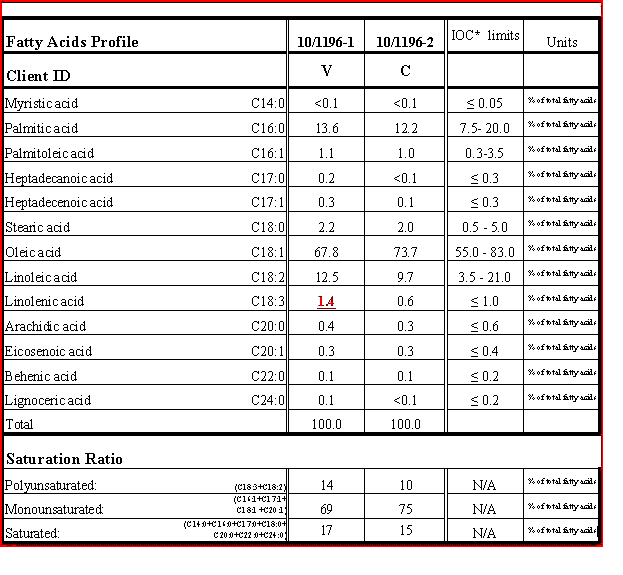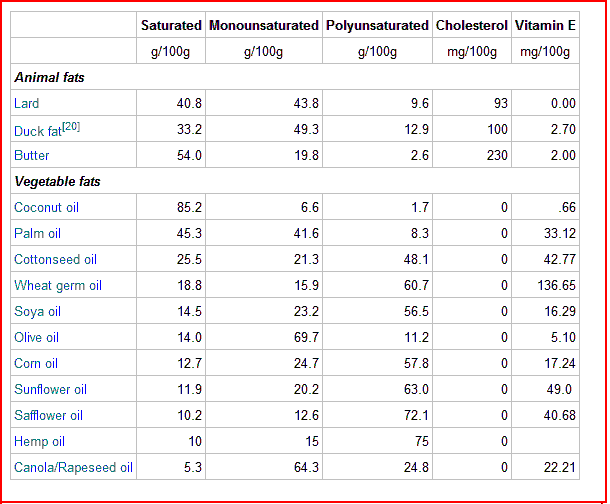Triglycerides
In lay terms, this is the fat fraction. Nutritionally it provides about 900Kcalories per kilogram ie. it is food from which we derive energy, amongst other things. Fat in the human diet is as important as protein, carbohydrates, vitamins, minerals and water.
Fats, in addition to providing energy, are important building materials for cell membranes and in the lipoproteins which transport lipids in the blood. They are
Precursors of some hormones and transport fat soluble vitamins (A,D,E,K) in the blood.
Linoleic and ?-linolenic fatty acids are essential to the body but cannot be made in the body. These polyunsaturated fats are known as essential fatty acids. You will have seen them listed in your fatty acid profile analysis of your olive oil.
We have a choice when eating fat, we can eat solid fats – such as butter – or liquid fats otherwise known as oils. Fats can come from animals or plants and are mainly made up of triglycerides, but also include sterols, phospholipids, glycolipids, vitamins and other substances.
Triglycerides are made up of glycerol and a fatty acid ie. Glycerol+fatty acid = triglyceride.
The determination whether a fatty acid is saturated (SFA), monounsaturated (MUFA) or polyunsaturated (PUFA) is dependent on the bonds linking various groups of molecules, whether they are double or single. Double bonds are unsaturated, single bonds are saturated. Again in layman’s terms if there is a double bond – like a double bed – there is room for one more. If there is a single bond – single bed – there is no room for anymore.
Then there is the complication that a compound may have one or more unsaturated bonds – like a dormitory with single and double beds. These are polyunsaturated fatty acids, those with one double bond are monounsaturated and those with only single bonds are saturated.
The more double bonds a fatty acid has, the more liquid it is. Animal fats are mainly saturated so are solid, vegetable oils are a mixture of mono- and poly-unsaturated fats so are more liquid.
Olive oil has 70-80% oleic acid which is a monounsaturated fat, and 8-10% polyunsaturated fats. On the other hand seed oils contain less monounsaturated fats and more polyunsaturated fats.
Below is a recent analysis of the fatty acid profile of two olive oils. The main saturated fats are myristic, palmitic and stearic. Monounsaturated is oleic and polyunsaturated are linoleic and linolenic.
The ratio of the different degrees of saturation are important as we will see from both a health and cooking perspective.
A comparison of the fat content of various other vegetable, oils is given in the table below (source Wikipedia) showing that canola oil compares favourably with olive oil in its high oleic acid (monounsaturated fat) content.

Chemical analysis of the fatty acid profile of two olive oils.

Comparison of the saturation ratio of various fats (Source Wikipedia)
Why have I gone to great lengths to explain the fatty acid content in olive oil?
Simply because there is an important difference in how saturated, polyunsaturated and monounsaturated fatty acids behave in relation to cholesterol movement through the body. Cholesterol is important in the structure of cell membranes.
Fats and cholesterol are not water soluble so when we ingest them they are transported as lipoprotein complexes in the blood. Large lipoproteins (high density lipoproteins -HDLs) are formed in the intestine and carry the triglycerides (fats) and cholesterol we eat to the liver. From the liver, after some processing, low density lipoproteins (LDLs) carry the lipids in the blood to the adipose (fat storage tissue). The LDLs are the main cholesterol carriers to the cells. There is a complex system that results in the cholesterol being dropped off at the cells for use in building and maintaining cell membranes, manufacturing bile acids, steroid hormones and fat soluble vitamins. But if anything goes wrong with the system, the LDLs cannot deliver the cholesterol at the right spot and it gets dumped in the arteries and causes the blockage problems we hear so much about.
Now, saturated fatty acids inhibit LDL receptors in the cells. Polyunsaturated fatty acids also inhibit cell cholesterol uptake. But, monounsaturated fatty acids do not inhibit cholesterol uptake by the cells and raise HDL levels. So olive oil, high in monounsaturated fats helps the body deal with excessive amounts of cholesterol.
Sterols
Olive oil contains phytosterols, the main ones being campesterol, ?-sitosterol and stigmasterol. ?-sitosterol counters the intestinal absorption of cholesterol.

